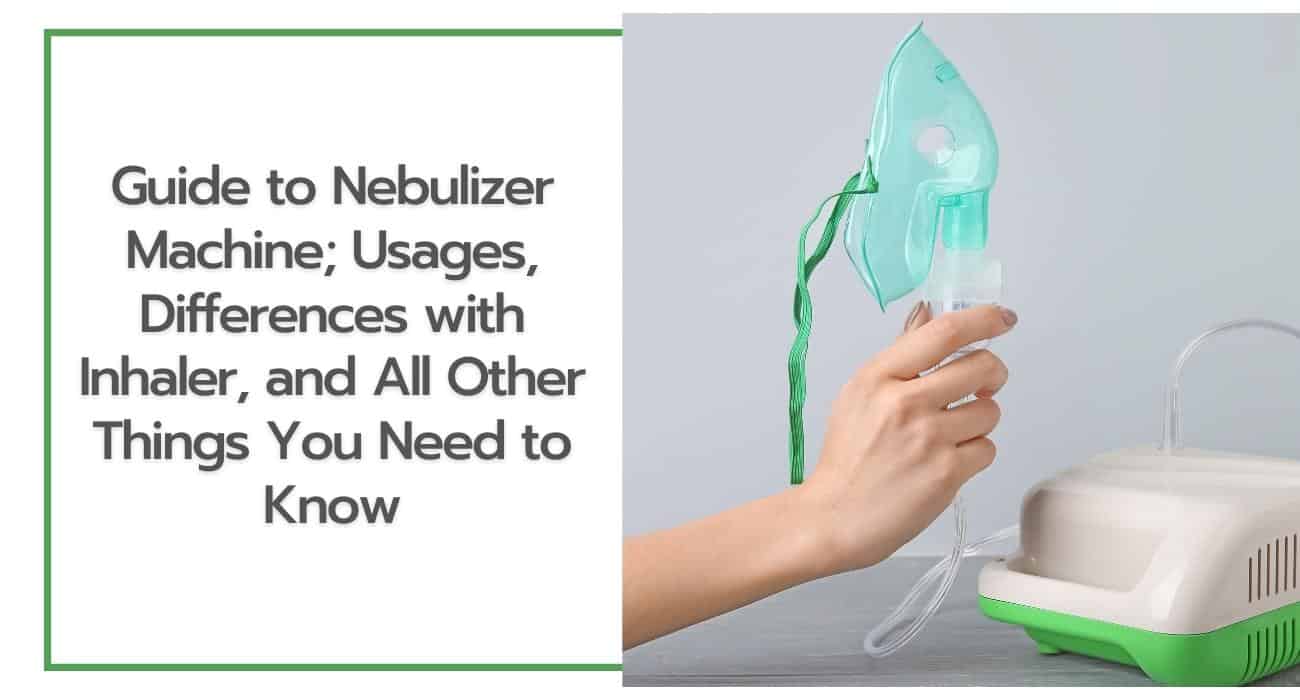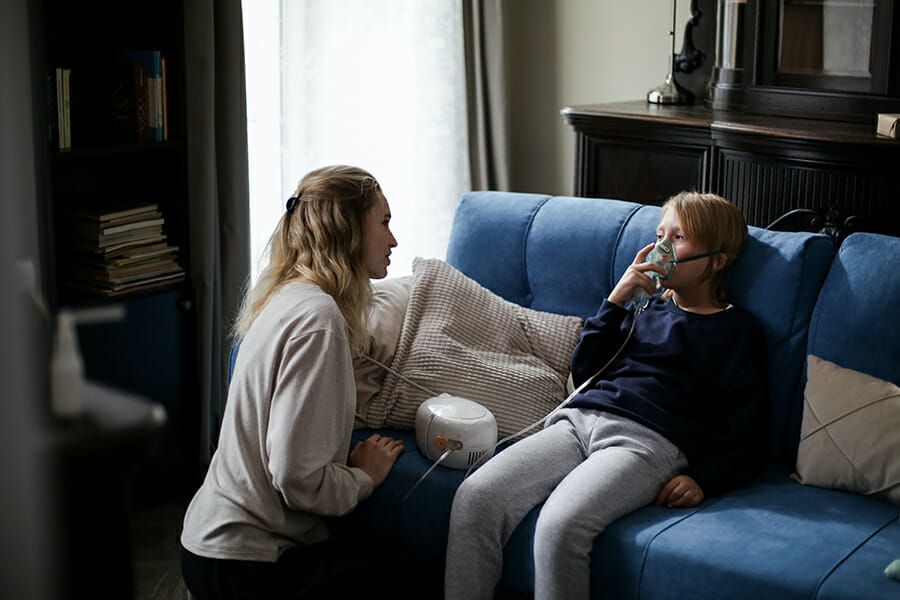Guide to Nebulizer Machine; Usages, Differences with Inhaler, and All Other Things You Need to Know

When someone has asthma, the airways become obstructed and inflamed, causing difficulty breathing, wheezing, coughing, and chest tightness. Treatment of asthma includes medication, lifestyle modifications, and sometimes your doctor may prescribe the use of an inhaler and/or nebulizer. So what is a nebulizer?

What is A Nebulizer Machine and How Does It Work?
A nebulizer machine is a device used to treat certain lung diseases, such as chronic obstructive pulmonary disease (COPD), asthma, or other respiratory disorders. It is a tool that helps to “inhale” medications directly and quickly to the lungs. This medical device will help people with lung problems breathe more easily and reduce the severity of symptoms.
The device works by turning liquid medicine into a very fine mist and then spraying it into the person’s lungs through a mouthpiece of the device. The nebulization process involves first creating a mixture of medication and oxygen using a compressor, then pumping the mixture through a tube into a valve, through a nozzle, into a patient’s mouth, and finally into the patient’s lungs. There are many types of nebulizers, including nebulizers for infants and nebulizers for adults.
Differences Between Nebulizers and Inhalers
Nebulizers and inhalers are two of the most commonly used devices for administering medications to respiratory diseases and asthma patients. There are no side effects from using the two devices; either a nebulizer or an inhaler. However, the two have distinctive features that make them useful for different types of patients. When using inhalers, patients are required to have the ability to inhale the medicine. Infants, young children, and people with severe respiratory diseases may find this more challenging. Fortunately, nebulizers tend to be easier to use in terms of administering medicine.
However, a nebulizer machine is not as portable as an inhaler, as inhalers are typically smaller, handheld devices, and more suitable to carry around. Furthermore, inhalers are able to deliver the medication instantaneously while nebulizers will need to take more time, between five to ten minutes.
So, which one is better? The answer depends on the individuals and their health condition. A doctor will likely prescribe to small children and people with severe asthma to use a nebulizer instead of an inhaler.
Medications Given with a Nebulizer
Below are common medications loaded into a nebulizer upon use:
- Budesonide
- Albuterol
- DuoNeb
- Ipratropium
- Pulmicort
- Xopenex
- Formoterol
- Sterile saline solution
- Antibiotics
Your doctor will determine which medications and the precise dose you need to take in the nebulizer based on your medical needs.
How to Use a Nebulizer
The Nebulizer is a machine that sprays medication into the patient’s nostrils. It is a relatively simple machine, as you only need to sit with the machine next to you and breathe in through a connected mouthpiece then the medicine goes into your lungs. Take slow deep breaths for ten to fifteen minutes or use your nebulizer according to the specific manufacturer’s instructions or as the doctor’s prescription.
Although some nebulizer machines may operate a little differently, generally the basic steps to set up and use your nebulizer are as follows:
- First of all, wash your hands thoroughly
- Place the machine on a flat surface where it can safely reach an outlet
- Make sure all the pieces are clean
- If your medication is premixed, fill it in the container. If you need to mix it, measure the correct amount, then place it in the container
- Assemble the tube or hose to the air compressor and the liquid container
- Attach the mouthpiece or mask, do it according to the machine’s manuals
- Turn on the nebulizer’s switch to check if the machine is misting
- Put the mouthpiece securely over your mouth and nose, make sure you leave no gaps so that all the medicine goes into your lungs.
- Breath in and out slowly until the medicine runs out which may take ten to fifteen minutes.
- Remember to keep the liquid container upright throughout the treatment to help administer all the medication.
- Turn off the nebulizer when you’re done
- To avoid the unpleasant taste of drugs, healthcare providers may suggest rinsing your mouth after the treatment
- Please ask the doctor or product manufacturer if you have any questions or concerns regarding the nebulizer.
How to Maintain and Clean the Nebulizer
The nebulizer should be cleaned and disinfected after each use to avoid any bacteria contaminating the device as they can be harmful and cause the lungs to suffer from dangerous infections. Below are the general guidelines to clean and maintain the nebulizer:
- Wash your hands and place the device on a clean surface
- Detach the tube, medicine chamber, mouthpiece, and wash them thoroughly in warm water with liquid dish soap.
- Place the component pieces on top of a clean towel to air dry
- Disinfect the components according to the manufacturer’s instruction card. Use a disinfectant solution or mix one part vinegar with three-part water as an alternative.
- Some component parts need to be replaced several times a year; for example, the tubing. Confirm this by consulting with the device’s manual to make sure how often you need to do this.
- Do not share your nebulizer device with another person.
Refer to the machine’s manual for recommended maintenance on your particular device. You can also ask nurses or pharmacists to demonstrate the cleaning process and tips to properly maintain the nebulizer.
Summary and Frequently Asked Questions
What is a Nebulizer machine?
A nebulizer is a medical equipment or device that turns liquid medication into a fine mist so that a person can inhale through a face mask or mouthpiece. This way will allow the inhaled medication to go directly to the lungs.
What is the purpose of the nebulizer machine?
A doctor may prescribe nebulizers to treat patients with respiratory conditions including chronic obstructive pulmonary disease (COPD) and asthma. The purpose of having this inhalation treatment is to reduce the number and severity of symptoms you have. A nebulizer is equally effective as an inhaler, but it is more convenient to use for infants, young children, and people with severe respiratory disease or those who are unable to hold their breath too long to use inhalers.
Are nebulizer machines over the counter?
Generally, pharmacies sell nebulizer machines over-the-counter, meaning it is possible for you to purchase the machine without a prescription. However, you will need a prescription from a doctor to purchase the medicine used with the device.
How much does a nebulizer machine cost?
Typically nebulizers cost anywhere between S$75 and S$300 or US$50 and US$220. The price depends on the type of nebulizer you will need. A portable nebulizer will cost higher than a regular one. Ask your healthcare provider for the recommended type that will work best for you.

